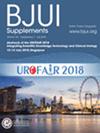What is lost in an average? Identifying distinct post-radical prostatectomy functional recovery profiles.
IF 4.4
2区 医学
Q1 UROLOGY & NEPHROLOGY
引用次数: 0
Abstract
OBJECTIVE To describe, via latent variable mixture modelling, distinct post-radical prostatectomy (RP) patient-reported outcome (PRO) recovery profiles, which are positioned to complement currently disseminated statistical averages for shared decision-making. PATIENTS AND METHODS Patients undergoing RP and completing the 26-item Expanded Prostate Cancer Index Composite 12 months after surgery were identified from the Michigan Urological Surgery Improvement Collaborative data registry. Hierarchical cluster analysis and latent variable mixture modelling was applied to urinary incontinence (UI) and sexual function (SF) recovery scores, and final models chosen based on optimal performance. RESULTS A total of 3956 patients comprised the study cohort. Three distinct UI profiles were identified with prevalence of 49%, 37% and 14% from best to worst recovery, respectively. Four distinct SF profiles were identified with prevalence of 14%, 24%, 42%, and 20%, from best to worst recovery, respectively. The last two SF profiles had similar function scores but differed based on perception of function being bothersome. Limitations include incomplete PRO capture, which may introduce bias. CONCLUSIONS We identify distinct UI and SF recovery profiles and their prevalence from a large, prospectively maintained registry, potentially improving interpretability of PRO data for decision making.平均损失了什么?明确根治性前列腺切除术后不同的功能恢复概况。
目的:通过潜在变量混合模型,描述不同的根治性前列腺切除术(RP)后患者报告的预后(PRO)恢复概况,以补充目前传播的统计平均值,用于共同决策。患者和方法接受RP并在术后12个月完成26项扩展前列腺癌指数综合测试的患者从密歇根泌尿外科改进协作数据注册表中确定。对尿失禁(UI)和性功能(SF)恢复评分进行分层聚类分析和潜在变量混合建模,并根据最佳性能选择最终模型。结果本研究共纳入3956例患者。确定了三种不同的尿失禁概况,从最佳到最差恢复的患病率分别为49%、37%和14%。四种不同的SF特征分别为14%,24%,42%和20%,从最好到最差的恢复。最后两种SF档案的功能评分相似,但基于功能令人烦恼的感知而有所不同。限制包括不完整的PRO捕获,这可能会引入偏差。结论:我们从一个大型的、前瞻性维护的注册表中确定了不同的UI和SF恢复概况及其患病率,这可能提高PRO数据的可解释性,用于决策。
本文章由计算机程序翻译,如有差异,请以英文原文为准。
求助全文
约1分钟内获得全文
求助全文
来源期刊

BJU International
医学-泌尿学与肾脏学
CiteScore
9.10
自引率
4.40%
发文量
262
审稿时长
1 months
期刊介绍:
BJUI is one of the most highly respected medical journals in the world, with a truly international range of published papers and appeal. Every issue gives invaluable practical information in the form of original articles, reviews, comments, surgical education articles, and translational science articles in the field of urology. BJUI employs topical sections, and is in full colour, making it easier to browse or search for something specific.
 求助内容:
求助内容: 应助结果提醒方式:
应助结果提醒方式:


